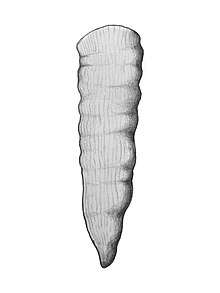Phaulactis
Phaulactis is an extinct genus of rugose coral that existed during the Ordovician, Silurian and Devonian periods. It can be found in Europe, North America, Asia and Australia.[1] Phaulactis was described by Ryder in 1926.[2]
| Phaulactis | |
|---|---|
 | |
| The species Phaulactis angusta | |
| Scientific classification | |
| Kingdom: | |
| Phylum: | |
| Class: | |
| Order: | |
| Family: | †Lykophyllidae |
| Genus: | Phaulactis Ryder, 1926 |
| Species | |
Description
All members of this genus is horn-shaped solitary corals, although the exact shape can vary between species. Phaulactis is most easily identified by its large amount of septa, deep calyx and distinct internal structure with three clear areas with different properties (but these sections are not always present in younger individuals). Another common trait is clear septal ridges.[3]
species
- Phaulactis angelini Wedekind, 1927
- Phaulactis angusta Lonndsdale, 1839
- Phaulactis clarkei Wedekind, 1927
- Phaulactis cyathophylloides Ryder, 1926
- Phaulactis gracile Wedekind, 1927
- Phaulactis högklinti Wedekind 1927
- Phaulactis iregularis Wedekind, 1927
- Phaulactis tabulatum Wedekind, 1927
- Phaulactis trochiformis McCoy, 1850
- Phaulactis variabilis Kato et Ezaki, 1986
gollark: Not really.
gollark: <@581484526925250570>
gollark: <@341618941317349376>
gollark: <@319753218592866315> Perl regexes can do primality tests.
gollark: Go Arch!
References
- "Phaulactis". Fossilworks. Retrieved 2019-06-09.
- "Phaulactis". Fossiilid.info. Retrieved 2019-06-09.
- LIV.—PYCNACTIS, MESACTIS, PHAULACTIS, GEN. NOV., AND DINOPHYLLUM, LIND. T.A.Ryder. Magazine of Nautural history. 1926.
This article is issued from Wikipedia. The text is licensed under Creative Commons - Attribution - Sharealike. Additional terms may apply for the media files.